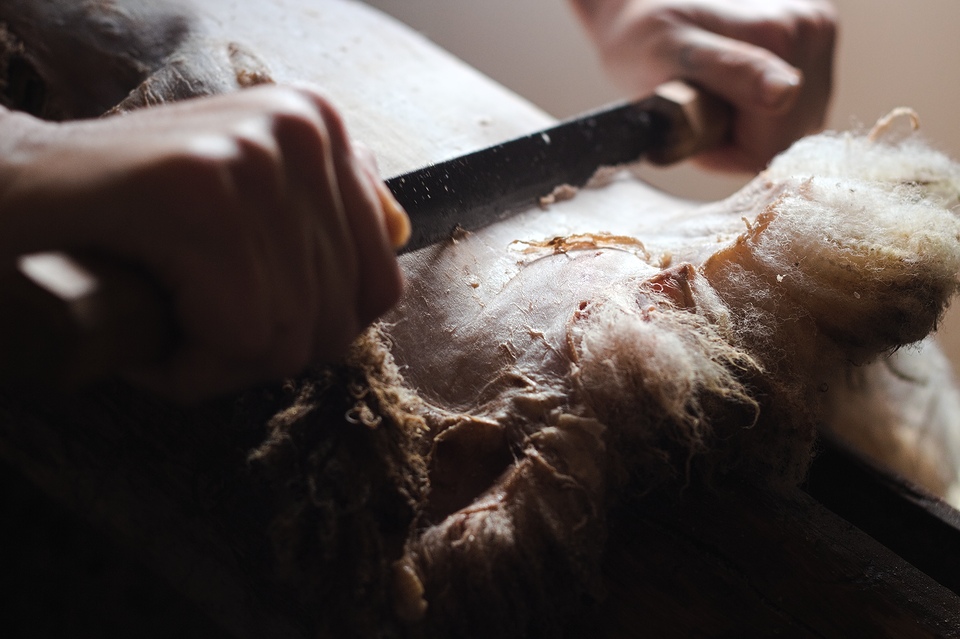Process & Care of Sheepskins
All of the sheepskins and leather that I offer are tanned naturally by me in my home workshop in the Blue Ridge/Appalachian mountains, where I also raise a small flock of sheep, meat rabbits and ducks. I have learned hide tanning from folk tanners and more production-based tanners, but mostly from my own years-long process of trial and lots of error! I am always refining my process, with the commitment to offer organically tanned sheepskins and leather products that are durable, heirloom-quality and free of heavy metals, alum, petroleum-derived solvents and synthetic oils and finishes. The ‘waste’ from my tanning process is used to mulch fruit trees and perennial herbs in my garden, so I use nothing I would not be comfortable eating. My hides are intended to be worn next to your skin, to be cuddled up with, to honor all of the gifts that the ruminant gives.
See available sheepskins

Cleaning & Care
Wool and tannins are naturally anti-microbial, so to keep your hide feeling fresh, all that’s needed is shaking out often, or beating the wool (a broom is great!) to release dirt and debris. If you have a clothes dryer with a tumble-only setting, you can pop it in there to shake out debris. You can also spot clean as needed to get rid of stains or spills, with no worry about getting the leather wet.
When a real deep clean is needed, my hides are fully washable! However, some breeds of sheep have wool that felts very easily, so I do not recommend putting them through a regular wash cycle. I fill my washer (or bathtub) with warm water, add a little mild soap or detergent, turn the washer OFF, and then submerge the hide with as little agitation as possible. When the water has cooled, you can use the spin cycle to spin out extra water, then line dry somewhere with good airflow. That’s it!
Drying in full sun will not harm the hide, but sun exposure will darken the tannins just like any veg-tan leather. If you want to keep the very light pink color of the leather, always dry in the shade. If you need to brush out the wool to remove debris, spritzing the wool with diluted vinegar and then working it into the locks can help give back that natural wave look. Iron will react with tannins to create black spots, so avoid hanging over metal fences when wet.
Common Questions
What ingredients are used to tan your sheepskins?
The primary tanning agent for my sheepskins is mimosa bark tannins, with additional ingredients for prepping, cleaning and softening the skin including: salt, citric acid, baking soda, soap, distilled vinegar, duck egg yolks, sunflower seed lecithin, and olive or avocado oil. Traditional Tanners in Ashland, Oregon are the first tannery in the US to get organic certification with the same process, and have been generous teachers. At this time I am not able to hand harvest and process bark for all of my hides, so I primarily use tannin extracts sourced from Traditional Tanners.
Where do you get your hides?
Some of the sheepskins I tan come from my own small herd of sheep, but most of the sheepskins come from the waste stream of meat processors in Appalachia, where no market for sheepskins exists and they would otherwise be sent to the landfill. Deerskins come from neighbors and friends here in the mountains who hunt to fill their freezer and are kind enough to save the hides for me. It is my hope that we no longer see hides as a "by product", but as highly valuable textiles in their own right, along with all of the other 'waste' of meat production: sinew, bones, and nutrient dense organs that were once cherished by our ancestors.
Do you offer custom tanning services?
I do tan some for other sheep farmers in southern Appalachia, but at this time my capacity is full.
